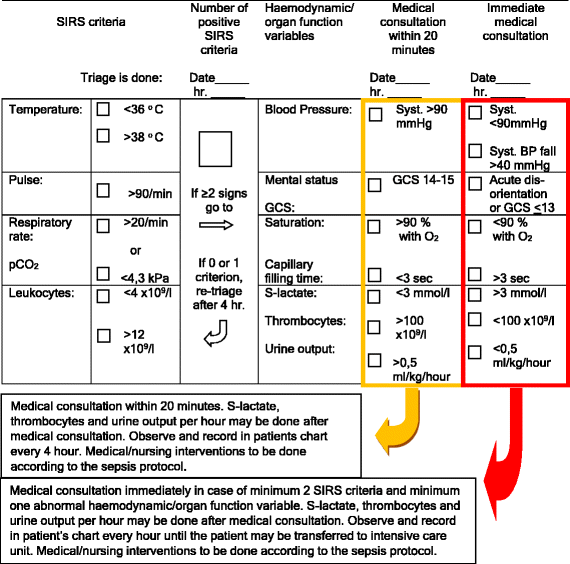Early identification of sepsis in hospital inpatients by ward nurses increases 30-day survival
- PMID: 27492089
- PMCID: PMC4974789
- DOI: 10.1186/s13054-016-1423-1
Early identification of sepsis in hospital inpatients by ward nurses increases 30-day survival
Abstract
Background: Systemic inflammatory response syndrome (SIRS) and sepsis are now frequently identified by observations of vital signs and detection of organ failure during triage in the emergency room. However, there is less focus on the effect on patient outcome with better observation and treatment at the ward level.
Methods: This was a before-and-after intervention study in one emergency and community hospital within the Mid-Norway Sepsis Study catchment area. All patients with confirmed bloodstream infection have been prospectively registered continuously since 1994. Severity of sepsis, observation frequency of vital signs, treatment data, length of stay (LOS) in high dependency and intensive care units, and mortality were retrospectively registered from the patients' medical journals.
Results: The post-intervention group (n = 409) were observed better and had higher odds of surviving 30 days (OR 2.7, 95 % CI 1.6, 4.6), lower probability of developing severe organ failure (0.7, 95 % CI 0.4, 0.9), and on average, 3.7 days (95 % CI 1.5, 5.9 days) shorter LOS than the pre-intervention group (n = 472).
Conclusions: In a cohort with stable mortality rates, early sepsis recognition by ward nurses may have reduced progression of disease and improved survival for patients in hospital with sepsis.
Keywords: Adherence; In-hospital; Sepsis; Survival; Systemic inflammatory response syndrome.
Figures


References
-
- Kenzaka T, Okayama M, Kuroki S, Fukui M, Yahata S, Hayashi H, Kitao A, Sugiyama D, Kajii E, Hashimoto M. Importance of vital signs to the early diagnosis and severity of sepsis: association between vital signs and sequential organ failure assessment score in patients with sepsis. Intern Med. 2012;51(8):871–6. doi: 10.2169/internalmedicine.51.6951. - DOI - PubMed
Publication types
MeSH terms
LinkOut - more resources
Full Text Sources
Other Literature Sources
Medical

